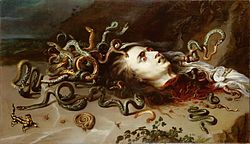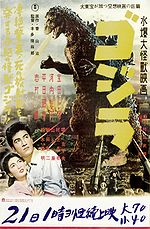This is an old revision of this page, as edited by 112.198.79.3 (talk) at 15:35, 26 February 2010 (→Post World War II). The present address (URL) is a permanent link to this revision, which may differ significantly from the current revision.
Revision as of 15:35, 26 February 2010 by 112.198.79.3 (talk) (→Post World War II)(diff) ← Previous revision | Latest revision (diff) | Newer revision → (diff) This article is about the legendary creature. For Monster (disambiguation), see Monster (disambiguation).| This article needs additional citations for verification. Please help improve this article by adding citations to reliable sources. Unsourced material may be challenged and removed. Find sources: "Monster" – news · newspapers · books · scholar · JSTOR (June 2006) (Learn how and when to remove this message) |
A monster is any fictional dangerous or hideous creature, usually in legend or horror fiction. The word monster derives from the latin word monstrum, meaning "omen", from the root of monere ("to warn") and also meaning "prodigy" or "miracle".
The word connotes something wrong or evil; a monster is generally morally objectionable, physically or psychologically hideous, and/or a freak of nature. It can also be applied figuratively to a person with similar characteristics.
Monsters in legend

Monsters in film
Pre-World War II

During the age of silent movies, monsters tended to be human-sized, e.g., Frankenstein's monster, the Golem, and vampires. The film Siegfried featured a dragon that was actually a giant puppet on tracks. A few movie dinosaurs were created with the use of stop-motion animated models, as in RKO's King Kong, the first giant monster film of the sound era.
Universal Studios specialized in monsters, with Bela Lugosi's reprising his stage role, Dracula, and Boris Karloff playing Frankenstein's monster. The studio also made several lesser films, such as Man-Made Monster, starring Lon Chaney, Jr. as an electrically reanimated zombie.
There was also a variant of Dr. Frankenstein, the mad surgeon Dr. Gogol (played by Peter Lorre), who transplanted hands that were reanimated with malevolent temperaments, in the film Mad Love.
Werewolves were introduced in films during this period, and similar creatures were presented in Cat People. Mummies were cinematically depicted as fearsome monsters as well. As for giant creatures, the Flash Gordon serial used a costumed actor to depict a large dragon. The cinematic monster cycle eventually wore thin, having a comedic turn in Abbott and Costello Meet Frankenstein (1948).
Post World War II

After World War II, however, giant monsters returned to the screen wit a vigor that has been causally linked to the development of nuclear weapons. One early example occurred in the American film The Beast from 20,000 Fathoms, which was about a dinosaur that attacked a lighthouse. Subsequently, there were Japanese film depictions, (vanny, Gamera), British depictions (Gorgo), and even Scandinavian depictions (Reptilicus), of giant monsters attacking cities. The most recent depiction of a giant monster is the monster in J. J. Abrams's Cloverfield, which was released in theaters January 18, 2008. The intriguing proximity of other planets brought the notion of extraterrestrial monsters to the big screen, some of which were huge in size, (such as King Ghidorah and Gigan), while others were of a more human scale. During this period, the fish-man monster was developed in the film series Creature from the Black Lagoon.
Britain's Hammer Film Productions brought colour to the monster movies in the late 1950s. Around this time, the earlier Universal films were usually shown on American television by independent stations (rather than network stations) by using announcers with strange personae, who gained legions of young fans. Although they have since changed considerably, movie monsters did not entirely disappear from the big screen as they did in the late 1940s.
Occasionally, monsters are depicted as friendly or misunderstood creatures. King Kong & Frankenstein are two examples of misunderstood creatures. Frankenstein's Monster is frequently depicted in this manner, in films such as Monster Squad and Van Helsing. The Hulk is an example of the "Monster as Hero" archetype. The theme of the "Friendly Monster" is pervasive in pop-culture. Chewbacca, Elmo, and Shrek are notable examples of friendly "monsters". The creatures of Monsters Inc. scare children in order to create energy for running machinery, while the furry monsters of The Muppets and Sesame Street live in harmony with animals and humans alike.
Monsters in gaming
Monsters are commonly used in fantasy or role-playing games, especially role-playing video games, when a large number of enemies to fight against are needed. However, the idea has been used across every genre to varying degrees. These can include aliens, all types of legendary creatures, or mutated versions of regular animals. However, sentient fictional races are usually not referred to as monsters. Other times, the term can carry a neutral connotation, such as in the Pokémon franchise, where it is used to refer to fictional creatures that may resemble, but are not, real world animals. Characters in games may refer to all animals as "monsters".
See also
- Aliens
- Cryptozoology
- Demons
- Flying Spaghetti Monster
- Fouke Monster
- Freak
- Kaiju
- Lake monster
- Legendary creature
- List of monsters
- List of monster movies
- List of species in fantasy fiction
- Monster movie
- Mutant
- Mythological hybrid
- Ogre
- Orcs
- Sea monster